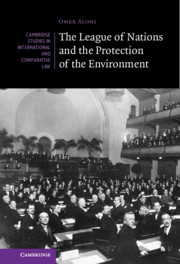Book contents
- The League of Nations and the Protection of the Environment
- Cambridge Studies in International and Comparative Law: 159
- The League of Nations and the Protection of the Environment
- Copyright page
- Contents
- Acknowledgments
- Introduction
- 1 Fighting Pollution Made by Humankind
- 2 The League of Nations and the Whaling Dilemma
- 3 Sanitation, Spreading Diseases, and Environmental Concerns: The League of Nations’ Campaign for Rural Hygiene
- 4 Raw Materials, the Timber Crisis, and Fears of Deforestation during the Interwar Period
- 5 Evaluating the Environmental Regime of the League of Nations: Comparative Discussion
- Conclusion
- Bibliography
- Index
- Cambridge Studies in International and Comparative Law
Conclusion
Published online by Cambridge University Press: 30 April 2021
- The League of Nations and the Protection of the Environment
- Cambridge Studies in International and Comparative Law: 159
- The League of Nations and the Protection of the Environment
- Copyright page
- Contents
- Acknowledgments
- Introduction
- 1 Fighting Pollution Made by Humankind
- 2 The League of Nations and the Whaling Dilemma
- 3 Sanitation, Spreading Diseases, and Environmental Concerns: The League of Nations’ Campaign for Rural Hygiene
- 4 Raw Materials, the Timber Crisis, and Fears of Deforestation during the Interwar Period
- 5 Evaluating the Environmental Regime of the League of Nations: Comparative Discussion
- Conclusion
- Bibliography
- Index
- Cambridge Studies in International and Comparative Law
Summary
This part concludes several of the key patterns in the League’s environmental regime. I use this opportunity to discuss some of the broader implications of this study for international environmental policymaking.
Next to the techno-environmental and legal questions covered in each chapter, the environmental story reveals the complex institutional framework of the League. I claim that the shift to internationalism was not only reflected in the substantive issues that were at stake. The interwar environmental regime was primarily based on a procedural and legal routine that supported the environmental challenges that confronted the League. The League brought something completely different into the table. The environmental law missions that I uncover show how and to which extent the League shifted these discussions and kept them going, thanks to its regular institutional routine. It was the League’s systematic – almost bureaucratic – institutional work that triggered these discussions, squeezing them into different modes of operation. In this way, these issues developed their own dynamic as part of international law.
Moreover, and although the League failed in many of its actions, including the environmental challenges, I will argue that given the layered structure of international environmental law (and its history), the interwar period should not be overlooked: not in terms of comparative legal history, and not in terms of its influence and links to the current issues of the ecological crisis.
Keywords
- Type
- Chapter
- Information
- The League of Nations and the Protection of the Environment , pp. 338 - 355Publisher: Cambridge University PressPrint publication year: 2021

